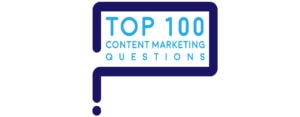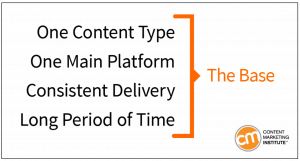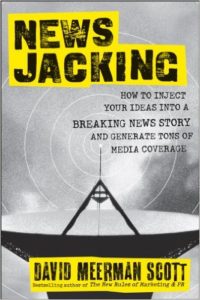
“How can teams with limited resources be best structured to impactfully address content needs?”
A marketer from Blackrock asked: “How can teams with limited resources be best structured to impactfully address content needs?”

Limited resources: a blessing or a curse?
It depends on how you look at it. I see limited resources as a blessing since they force you to focus on David vs. Goliath content marketing.
If you have limited resources:
- Prepare by taking 7 steps to fast-forward your content marketing.
- Make one big bet. Focus on creating one piece of content – a content base – a big asset your competitors can’t easily replicate.
- Empower a small team that has the right skill sets – a storyteller, a marketer, and an expert in conversion.
- Generate news and use newsjacking to win media coverage.
Limited Resources? Preparation is how you win a David-vs.-Goliath battle
Small players beat bigger players by tricking them and outsmarting them. When you’re David, your slingshot is content marketing.

Preparation means that you don’t try to take shortcuts. Instead, take 7 steps to fast-forward your content marketing:
- Write down your content marketing mission in 5 steps.
- Write down your one-page content marketing strategy. Build a big tent to co-create your content mission and strategy to get faster and deeper buy-in inside the company.
- Co-create a Message Map, one crisp, clear, consistent message that tells buyers what’s in it for them.
- Do buyer persona research so you have the best insights into your customers and how they make decisions.
- Map content to the steps in the buyer’s journey.
- Do a competitive content audit to identify the white spaces where you can build since competitors are absent.
- Use all-in analytics to measure, fine-tune and improve content performance, and to prove business results.
Big companies assign big teams, do big campaigns, and expect big results fast
Your competitors may be bigger companies with richer resources: more people, more money, and stronger brands. But, Fortune 500 companies often get bogged down in bureaucracy and sheer size. For instance, it creates blind spots and slow reflexes.
Big companies deploy tons of content marketing tactics simply because they can. The Goliath approach is to do everything possible, such as:
- Social Media
- E-Newsletters
- Articles
- Blogs
- In-Person Events
- Case Studies
- Videos
- Illustrations
- Photos
- White Papers
- Mass Media
- Online Presentations
- Infographics
- Webinars
- Webcasts
- Research Reports
- Microsites
- Mobile Apps
- Print Magazines.

None of these tactics is bad. The problem is, that each one is jockeying for attention and subtracting focus from the others.
What’s more, many big companies lack the patience to stick with any tactics for long enough to make a difference. They pull the plug too soon. So content never gets a fair chance to build value over time.
In a content marketing landscape, using too many tactics is like landscaping your yard with lots of shrubs. Instead, plant one tree that will, in time, grow tall enough to tower over competitors.

“Produce the minimum amount of content to produce the maximum results,” Robert Rose says. That’s how David thinks, but it’s not how Goliath thinks.
Focus first on building the one type of content that makes all the difference – your content base.
Start small. Focus on one idea to make a big difference
Make one big bet and put everything behind it. Build a content base by focusing on one content type, one main platform, and consistent delivery over a long period of time. This is what the Content Marketing Institute advocates.

Learn from others who built a content base
Consider The Guinness Book of World Records. The inspiration for the book came when Sir Hugh Beaver, the managing director of the Guinness brewery, went on a hunting trip with friends.

The hunting party got into a heated argument about what is the fastest game bird in Europe. Who knows, they may have been drinking ; )
Back home, they could not find an answer to their question in any reference book. So, they hatched the idea of a book that would settle arguments in pubs.
Their brilliant insight was to write not about beer, not about pubs, but instead to ladder up from those topics to write for their tribe – people who drink Guinness in pubs.
Lack of Resources
Talk about lack of resources: Twin brothers Norris and Ross McWhirter wrote the first edition in only 13½ weeks, by working 90 hours a week.
First published in 1955, The Guinness Book of World Records became an immediate best-seller. By 1964, 1 million copies had been sold.
The book was published in many other languages, then made into a BBC TV show called Record Breakers. In 2001, The Guinness Book of World Records was sold for $65 million.
This is proof positive that a content base, built over time, becomes a valuable asset. When you have only small resources, building a content base is the smartest thing to do first.

Other examples of content bases include:
- The annual Edelman Trust Barometer.
- The Content Marketing Institute’s annual research.
- The Michelin Guide.
- The GE Radiologists and Radiology Technologists Salary Guide.
- The Dollar Shave Club’s Bathroom Minutes.
- Service Experts’ book, Home Heating and Cooling for Dummies.
- The Home Made Simple website.
- Our library of answers to marketers’ Top 100 Questions on content marketing.
Goliath moves slowly …
That means you can run rings around him with a small team.
David’s natural advantages are speed and nimbleness. Small organizations can move much faster than big ones. In fact, that’s how they can beat the big ones.
Big companies design processes to minimize risk rather than to achieve speed or marketplace advantage. Organizational complexity and bureaucracy often encumber marketers with many siloes, inflexible processes, and predetermined tools.
Marketers in big companies need to run everything up the ladder and gain many approvals. That can take weeks or months.
As David, focus on finding ways to go faster:
- Agree in advance to minimize the number of people who have to give an ok before publication.
- Gain advance buy-in by co-creating your mission, strategy, and message.
- Grant a chief content officer or editor full authority to make real-time editorial decisions, to open the door to newsmaking and newsjacking.
Become a newsmaker
What can you do to propel your company into news media headlines?

REI arrested attention by launching its #OptOutside movement as an alternative to Black Friday.
When REI closed all its stores, they encouraged customers to go outside instead of going shopping. That surprising, brilliant counterpoint to the usual Black Friday shopping stories won mega-attention.
Create content tied to industry trade shows
Or try this idea: create newsy content tied to major industry trade shows.
On the first day of trade shows, marketers at Tellabs regularly fielded industry surveys designed to stir controversy. (Full disclosure: I worked in VP-marketing and communications at Tellabs for 14 years, until private investors bought out the company.)
For example, we asked telecom experts: Do you expect a major outage on the Internet – a blackout or brownout – in the next 3 years?
Nearly half of them did!
That made headlines and won media attention. We compiled and published survey results overnight, enabling a news release to appear on the second day of a show. Moving fast made all the difference.
Controversy ignites news: try newsjacking
The more controversy, the bigger the news.
Turn your existing evergreen content into news through newsjacking.
Newsjacking means that you hijack a news or trend story to gain attention for your brand. Successful newsjacking requires you to monitor news in real-time, anticipate future events, improvise, and set up a quick-approval process in advance.

David Meerman Scott, the author of the book Newsjacking, shares a story about how an Australian insurance company won news coverage by writing a gimmicky insurance policy and publicizing it through a news release.
When former President Obama visited Australia, the company issued a news release, offering Obama free insurance against a crocodile attack. Since all the media were reporting on Obama’s visit, that gimmicky story generated outsize news coverage for the insurer.
To pursue newsjacking, make a comprehensive list of upcoming events that are expected to occur — those that affect your company, customers, and rivals. Think through news angles and prepare as much as you can in advance, so you can strike quickly when news breaks.
For content marketers, news can be a force for good or for evil. Here are 9 lessons content marketers can learn from the news media.
“How can teams with limited resources be best structured to impactfully address content needs?”
- Prepare by taking 7 steps to fast-forward your content marketing.
- Make one big bet. Focus on creating one piece of content – a content base – a big asset your competitors can’t easily replicate.
- Empower a small team that has the right skill sets – a storyteller, a marketer, and an expert in conversion.
- Generate news and use newsjacking to win media coverage.
This is one of marketers’ Top 100 Questions about content marketing. Here are the answers.
Related Posts
Content Marketers: What’s The #1 Reason Buyers Leave Websites?
Reason Buyers Leave Websites Websites can repel users if they lack contact information, push animated ads, offer poor design and navigation, or startle with automatic audio and video. But...
Keeping the peace between Marketing and Sales
Many years ago, I came home one evening muttering about a salesperson I worked with. My life partner let me vent for a few...
Top 100 Content Marketing Question: How to value the impact of content marketing and justify the expense/overhead?
Get the whole team aboard To demonstrate the impact of content marketing, start by getting your executives and internal clients aboard the content marketing...
Presenters: Don’t let the audience in on your doubts
Once again, I didn’t set out to write a blog about presenters while watching an episode of the YouTube talk show Hot Ones. (My...





